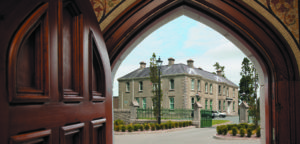LAUNCH OF
‘ARCHDIOCESE OF ARMAGH – A HISTORY’
BY THE RT REV. MONSIGNOR RAYMOND MURRAY
CARDINAL TOMÁS Ó FIAICH MEMORIAL LIBRARY AND ARCHIVE
ADDRESS BY CARDINAL SEÁN BRADY
3 MAY, 2000
I gladly join in welcoming you all here this evening. We come together for a very special event in this special year – The Year of the Great Jubilee.
Jubilee connotes joy. That joy is, of course, a joy of the Spirit – deep immense joy – at the news that God loved the world so much that He gave His Son, to be its Saviour.
The coming of the Saviour aroused many kinds of joy – The angels sang at his birth – the disciples rejoiced at his Resurrection. The fact is that God’s Revelation of Himself as Creator and Saviour arouses in people a tremendous joy.
Our celebration this evening is a result of that joy. It is an occasion for celebrating. I am personally delighted to launch Archdiocese of Armagh – A History by Monsignor Raymond Murray.
It is being published as part of our Diocesan celebration of the Great Jubilee. The history of the diocese speaks of God. It remembers the wonderful works that God has done in our local Church. The study of history makes us aware of the past. There we discover the seeds of inspiration and guidance for the future.
I know that this history can play a very important role in increasing our awareness of God’s love at work in our lives. My fervent hope is that it will, in fact, play that part and play it very effectively.
Christianity has been in Ireland for the past 1500 years. There is therefore in existence a history of the Christian religion – there is a story to be told. This short history of God’s people in the Archdiocese of Armagh tells that story. It tells that story from the time of Patrick to the present day and it tells it well. It tells it in summary but also in scholarly fashion, as we might expect from the pen of Monsignor Murray. As the author says in the Foreword “This is a story of the steadfast loyalty of God’s people even though their hearts were darkened by crisis and tragedy”.
Monsignor Murray sets out in 14 chapters, the signposts which give us bearings to our ecclesiastical history. There are facts of life and human characters in it. There are, of course, terrible happenings, for which governments and Churches must beat their breasts. But coming through also is the inner spiritual life of the Church, the piety, humility and charity of many, the wisdom and the beauty.
When you consider the social and political experience of people down the ages, people struggling for an existence, with various powers struggling for dominance and rule, never forget that all the time there have been tens of thousands of priests and ministers and holy women preaching the Gospel. They were challenging people to think of the great issues of life, offering them healing from sin and sorrows, offering them consolation and hope. The number one sign of hope in the Church is holiness.
This book reminds us of the little people. It tells the story of the small and the forgotten but it also tells the story of the saints – canonised and uncanonised, the story of –
Patrick,
Brigid,
Moninne,
Malachy,
Richard of Dundalk,
Archbishop Richard Creagh,
Father Patrick Loughran,
Dean James O Fallagan,
St. Oliver Plunkett,
Dean Brian MacGurk and many others.
I was very impressed by the excellent publications of Éditions du Signe. I was easily persuaded by Dr. Claude Costecalde that parishes and people should celebrate the Jubilee by telling the story of Christianity in our diocese. My belief is that this volume will be an inspiration to them and especially to our young people. For even in the worst of times there was a light that never went out. There have always been people who hold on preciously to the spiritual life. The ordinary Christian piety in Ireland for the past 1500 years appears to me to be something wonderful.
So, I wish to thank the priests and parishes of the diocese who have understood the evangelistic nature and potential of this project and who have responded in such a wonderful way.
Last year I asked Monsignor Murray, at very short notice, to write this book. Within three months he provided the text so that all the other procedures that go into the production of a book could speedily follow and that we would have it for the Easter period. I have read this book. I praise him for his scholarship and thank him for the time and effort he has put into it. I congratulate him on this fine achievement.
In it Monsignor Murray has caught up a tradition in the diocese that goes back to the renowned Father Lorcan O’Múirí. Fr Lorcan has laid the foundations for the history of the diocese in the Co. Louth Archaeological Journal. The late Cardinal Tomás O Fiaich built on those foundations and followed in his footsteps by founding the Seanchais Ard Mhacha. Now it is gratifying to see one of his most brilliant students carry on that work to a further fulfilment and give us an excellent perspective of the Armagh Church from Patrick to the present century.
Of course Monsignor Murray has had plenty of experience in writing. History and the Irish language have always been close to his heart. He was well equipped to write this summary history. I think it was, for him, a labour of love. In the final chapter Monsignor Murray refers to the conflict of the last thirty years. He speaks about priests and ministers of religion and peace activists who helped to defuse many difficult situations. I would like on this occasion to pay tribute to all those who did so and especially to Monsignor Murray and his courageous work for justice, as the essential foundation of any lasting peace.
Monsignor Murray has once again placed all of us in his debt. In your name I express to him our sincere thanks. We can help the fulfilment of his wish that this volume may provide inspiration for Christian living by urging people to take it up and read it. The clarity of the text is equalled only by the beauty of the photography which exemplifies so much beauty that is associated with the Church. This delightful volume illustrates the beauty, which the Christian religion has inspired in buildings and paintings, in stained glass and sculpture and High Crosses.
I was in the USA last week and I presented this history to a number of people. I want to quote from a letter I received from the Bishop of Bellvill, in Illinois, singing its praises. He said, “Thank you sincerely for the gracious gift of Archdiocese of Armagh – A History by Monsignor Raymond Murray. I found it both a delightful and a charming narration of the rich heritage that belongs to the venerable See of Armagh. I shall share it with a host of friends whose personal heritage and deep affection for Ireland are gifts for them as well as for myself”.
I thank you all for coming for this celebration. I am sure you will enjoy the book. Congratulations and thanks to Dr. Claude Costecalde, to Patrice Thébault and to Éditions du Signe for the beautiful book they have produced. Its layout, printing and illustrations are superb. My special thanks to Cumann Seanchais Ard Mhacha for organising the launch and to The Cardinal Tomás O’Fiaich Memorial Library and Archive for the lovely surroundings for the occasion.



You must be logged in to post a comment.